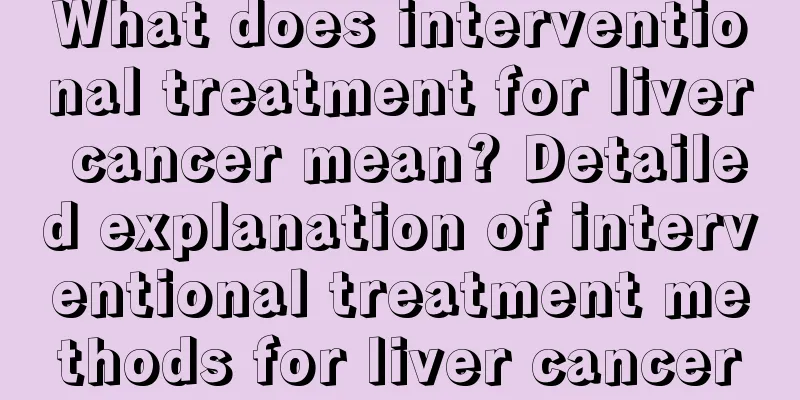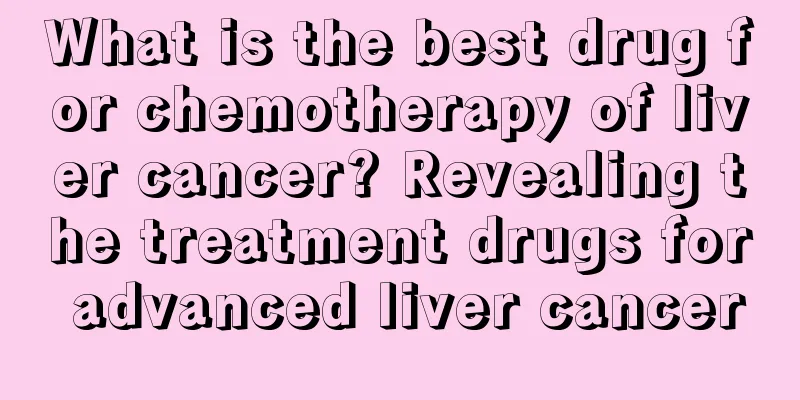What does interventional treatment for liver cancer mean? Detailed explanation of interventional treatment methods for liver cancer

|
We all know that there are many ways to treat liver cancer, but not every method is satisfactory. Due to the limitations of many medical environments and conditions, the cure rate of liver cancer is not high. Interventional treatment of liver cancer is one of the more effective methods. It is very necessary to let everyone know the advantages and disadvantages of this method. As we all know, liver cancer may have a fatal impact on the human body, so many people are very afraid to hear about this disease. But no matter how hateful the disease is, we should face it without fear, including understanding the treatment methods of the disease. Interventional treatment of liver cancer is a very effective one. It can effectively remove the impact of cancer on the human body, and often there is no recurrence phenomenon. It is indeed very beneficial to the human body. The following is a comparison of the types of interventional treatments for liver cancer and various advantages and disadvantages. I hope it will be helpful to everyone. 1. Transvascular interventional therapy The most common method is to use vascular interventional therapy. It is done by puncturing the femoral artery, and then injecting chemotherapy drugs and embolic agents from the femoral artery into the hepatic artery under fluoroscopy. Liver cancer patients have a single blood supply, so interventional therapy for liver cancer patients is relatively simple technically. The effect of interventional therapy for liver cancer is very good. Embolization therapy can occlude tumor blood vessels and shrink the tumor blood vessels to achieve the purpose of treatment. Interventional therapy is very reasonable for liver cancer patients. 2. Non-vascular interventional therapy For non-vascular interventional treatment, a commonly used method is percutaneous transhepatic ablation therapy. Whether it is radiofrequency or cryosurgery, these local interventional treatments are called ablation therapy. The percutaneous transhepatic approach uses physical or chemical methods to deliver anticancer substances to the tumor locally, causing the tumor to be ablated and necrotic. Comparing vascular interventional treatment and non-vascular interventional treatment, vascular interventional treatment is more mature and has relatively good results and no recurrence because of its wide range of indications. Non-vascular treatment methods are relatively limited. Some patients are not suitable for non-vascular methods. |
Recommend
Pubic pectinate ligament
Normal adult men and women have an area with pubi...
The hazards of low temperature baking
When eating baked goods, most people will choose ...
Method for selecting medication for osteosarcoma
After suffering from osteosarcoma, patients will ...
What are the acupuncture points around the eyes
What acupuncture points are there around the eyes...
Main causes of primary liver cancer
The main causes of primary liver cancer include g...
How can liver cancer patients exercise to benefit their health
The diagnosis and treatment of liver cancer is im...
4 common treatments for ovarian cancer
Ovarian cancer is a complex disease, and its caus...
What are the symptoms of mushroom poisoning and how to treat it?
Mushrooms are a very important ingredient in life...
How to solve knee pain caused by lumbar disc herniation
Lumbar problems have always been one of the facto...
Headache and cold body
People's bodies are more sensitive to the out...
How much does targeted treatment for nasopharyngeal carcinoma cost
The current development is also relatively fast, ...
Why do liver cancer patients always feel tired? Prevention of liver cancer starts from here
Liver cancer is one of the common malignant tumor...
Does high glutamyl transpeptidase mean liver cancer? Not necessarily, but there are many possibilities
High glutamyl transpeptidase does not mean liver ...
What should children eat when they have internal heat?
Children are angels, sometimes they are gentle an...
What are the symptoms of recurrence and spread of ovarian cancer
Ovarian cancer is very harmful to women's bod...









